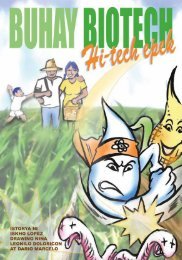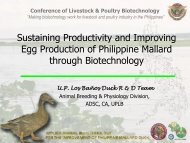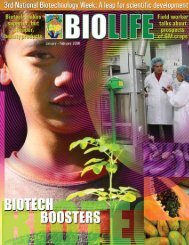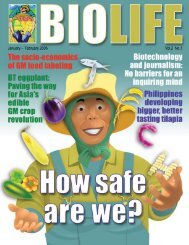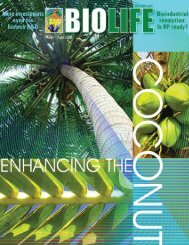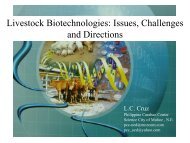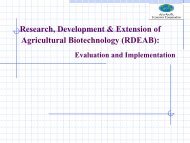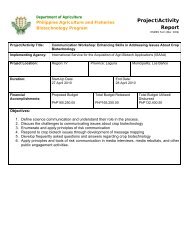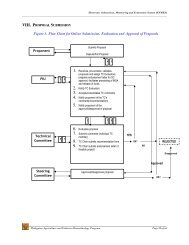Download PDF - SEARCA Biotechnology Information Center
Download PDF - SEARCA Biotechnology Information Center
Download PDF - SEARCA Biotechnology Information Center
Create successful ePaper yourself
Turn your PDF publications into a flip-book with our unique Google optimized e-Paper software.
26 BIO LIFE January – March 2005<br />
Agricultural biotechno<br />
By ISKHO F. LOPEZ<br />
FOOD SECURITY concerns the<br />
availability of food in a community<br />
and having sufficient supply. The<br />
community either produces the food or<br />
buys from outside the community.<br />
Food production depends on the level<br />
of skills and on what is provided by natural<br />
resources. Should the community prove to<br />
be inadequate in producing food and its<br />
natural resources are scarce, and at the<br />
same time it is unable to afford food from<br />
outside, then food security is expectedly low.<br />
In places where natural resources are<br />
abundant, the community needs to<br />
develop the proper food production skills in<br />
order to make the most of what its natural<br />
resources can offer. And therein lies the<br />
challenge to productivity.<br />
Developing food production skills<br />
involve transfer of technology or the use of<br />
scientific or other organized knowledge<br />
and its application to practical tasks in<br />
order to improve or enhance food productivity.<br />
Where such technology reduces<br />
reliance on skills, the result would be an<br />
increase in food security. As it has been<br />
proven, genetically modified organisms<br />
(GMOs) help increase food security, and<br />
an example would be the stalk borerresistant<br />
maize.<br />
The Philippine government has<br />
adopted a policy to promote the safe and<br />
responsible use of biotechnology as one of<br />
the means to achieve food security,<br />
according to Dr. Saturnina Halos, Senior<br />
Project Development Adviser of the<br />
Bureau of Agricultural Research of the<br />
Department of Agriculture. “As a developing<br />
country, the Philippines has a large<br />
proportion (40percent) of its population<br />
dependent on agriculture,” explains Halos.<br />
She points out that individual farms in<br />
the Philippines are relatively small with the<br />
average size being about 1.5 hectares.<br />
Such farms usually support a family of 6-<br />
12 persons. These farms would have<br />
variable soil fertility, and some would<br />
contain problem minerals. Rainfall in these<br />
places would be variable and access to<br />
markets, while easy for some, would be<br />
difficult for many others.<br />
Providing a sketchy profile of Filipino<br />
farmers, Halos says these farmers’<br />
Benjo 04




